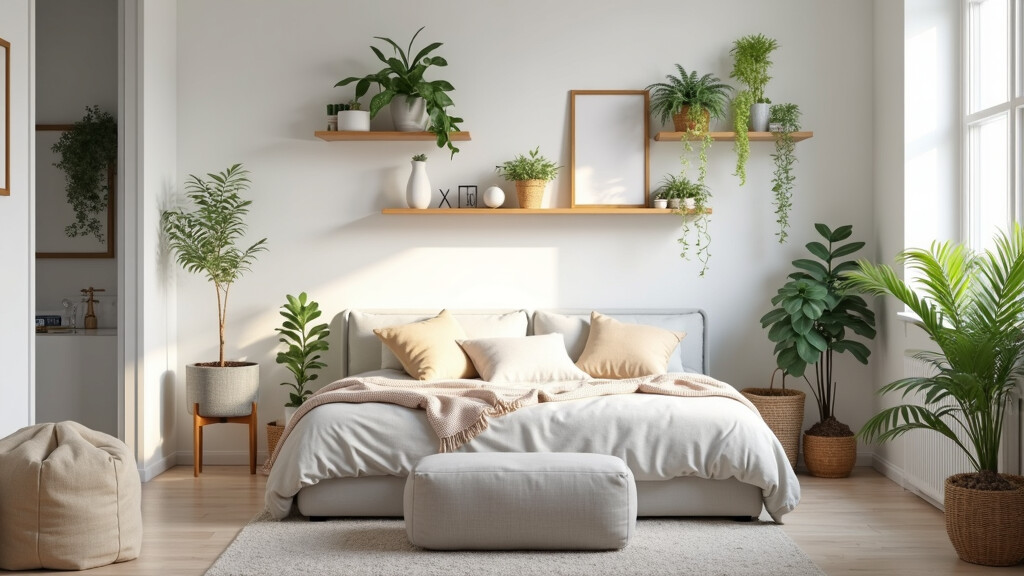
Fitting everything I need into a small living area can be a challenge. Balancing comfort, function, and space takes some creative thinking. Over the years, I’ve picked up quite a few practical storage solutions that work well in tiny apartments, studios, or small rooms. Here, I’m sharing clever ways to maximize every inch, so you can enjoy your home without feeling crowded.
Understanding Storage Needs in Small Spaces
Living in a small space really makes me focus on what I use every day. Personal habits, the number of people sharing the home, and what I value most (like clothes, books, or hobbies) guide what storage solutions work best for me. Knowing my own needs helps me decide whether I should add vertical shelves, look for hidden storage, or reorganize my closets. According to real estate studies, smart storage can help increase the appeal and functionality of a small home. That’s something potential buyers or renters notice quickly (National Association of Realtors).
Tiny homes and microapartments are more popular than ever, so finding new storage tricks is a growing trend. Even with just a few hundred square feet, making careful choices keeps life feeling uncluttered and calm. I’ve found that applying a few well-placed solutions can change the whole feel of a room overnight. It’s rewarding to see how a couple of simple tweaks can really open up your living area and add to your overall comfort.
Smart Solutions for Everyday Storage Challenges
Small spaces often have awkward corners or tricky layouts. Over time, I’ve learned how to spot underused areas, like under the bed, high up on walls, or even the backs of doors, and turn them into functional zones. Built-in shelving, multipurpose furniture, and modular systems go a long way in making the most out of what you have.
Popular storage solutions include:
- Floating Shelves: Add storage above desks, beds, or doors, without taking up precious floor space.
- Storage Ottomans: These do double duty; serving as seats, tables, and hidden bins for blankets, games, or shoes.
- Closet Organizers: Using racks, baskets, and cascading hangers can double the capacity of even a small closet.
A mix of open and closed storage is helpful. Open shelves work for books or plants, while boxes and drawers hide away the messier stuff. This balance keeps things calm and tidy but still lets me get to my favorite things quickly. For example, keeping much-used kitchen spices in open view, but storing cleaning supplies out of sight, has made my own space calmer and more inviting.
Step-by-Step: Building Better Storage in Small Rooms
When I reorganize or add storage in a small area, breaking the process into simple steps makes the job less overwhelming. Here’s a quick process that has worked for me:
- Declutter First: Go through items and keep only what I actually use or love. Removing extras instantly frees up space.
- Measure Carefully: Accurate measurements help me choose solutions that actually fit, preventing wasted purchases.
- Think Vertically: Look up; add shelves or tall cabinets to boost storage without crowding the floor.
- Choose DualPurpose Pieces: I look for beds with drawers underneath, tables that expand, or sofas with builtin storage.
- Group Like Items: Organizing by category (all shoes in one bin, all hobby supplies in one drawer) saves me time later when I’m searching for things.
These steps always give me a solid foundation and prevent rooms from getting too cluttered as life changes. When life gets busy, having a system I can rely on helps keep things under control, so I don’t feel overwhelmed by piles of stuff.
What to Think About Before Buying Storage Solutions
Buying storage isn’t just about picking the nicest basket on the shelf at the store. I ask myself a few questions before bringing anything new home:
- Does it fit my space? I measure available areas before buying to avoid returns or wasted money.
- Is it flexible? Multipurpose items last longer if I move or change my lifestyle.
- Will I use it regularly? Storage should make things easier to access, not harder. If it’s all the way at the back of a deep closet, odds are I’ll forget about it.
- Could I DIY a better solution? Sometimes, customizing a basic shelf or creating something with hooks and basic tools is a lot more satisfying, and budgetfriendly.
Asking these questions has helped me avoid collecting bins or baskets that turn into clutter themselves. Taking the time to consider each new addition really pays off, as unnecessary purchases can eat up valuable square footage and money.
UnderBed Storage
Beds take up a lot of floor space. Sliding drawers, wheeled boxes, or sturdy storage bags can turn unused space into the perfect spot for offseason clothing, shoes, or spare linens. I use labeled bags with clear tops so I can see what’s inside, and there’s no need to dig through every box when I’m changing out sheets or jackets.
Creative Kitchen and Entryway Solutions
Tiny kitchens benefit from hanging racks for pans, magnetic strips for knives, or even stackable shelves inside cabinets. I added a slim rolling cart between my fridge and wall; that instantly claimed a hidden storage area for pantry items. Drawer dividers, especially those that fit snugly, can really make a difference too.
Entryways are usually small but really set the tone for the rest of a home. Wall hooks, narrow shelves, and overthedoor shoe organizers can all fit coats, shoes, and bags neatly by the front door. I even used a narrow bench with basket storage underneath to give guests a convenient spot for their own shoes and bags when they visit.
Open Storage Versus Closed Storage: Finding the Right Mix
Having some things out in the open helps me grab and go, especially when life gets busy. But closed bins, drawers, and cabinets keep the visual noise down. Organizing open shelves by color or in matching containers adds style while remaining practical. I try to keep open shelving limited to wellused or visually pleasing items, while tucking away the rest behind closed cabinet doors or in decorative boxes.
Pro Tips and Tricks for Getting More Out of Your Small Space
Over time, I’ve learned a few tips that make smallspace storage even more effective. Here are a few you might find helpful:
Use Wall Space Smartly: Hang floated cubes, pegboards, or upright cabinets. I keep frequently used items within arm’s reach and lighter, decorative ones higher up.
Opt for Transparent Containers: Clear boxes and jars save me the hassle of opening every bin to find what I need.
Keep It Light: Lighter colors on walls and shelving create an open, airy feeling, even when storage fills most of the space.
Rotate Seasonally: I swap out clothes, shoes, and even hobby supplies each season. Offseason items get stored away, freeing up my main living zone. Even my holiday decor gets the same treatment, so only what’s in season is out in the open.
Trying these ideas has made a real difference in how comfortable and organized I feel at home. It’s surprising how much stress disappears just by having things in their place.
RealLife Examples of Clever Storage in Small Spaces
In my last apartment, builtin window benches with storage beneath doubled as places to read and spots to keep spare bedding. In kitchens, I’ve installed stackable organizers and magnetic knife strips that kept counters clutterfree. Some friends use hanging baskets for fruits and vegetables, making even small pantries feel twice as big.
- Home Office Corners: Floating desks attached to the wall paired with cube storage keep work zones efficient and stylish, even in the tightest spaces.
- Vertical Gardens: Hanging planters or wallmounted herb racks bring greenery home without crowding tables and shelves.
- Bathroom Helpers: Over the toilet shelves, baskets mounted on walls, and stackable drawers make the most of limited bathroom storage.
When space is limited, every inch really matters, so finding unique fixes for common problems can make daily routines feel a little easier. I’ve seen friends use ladders as towel racks in bathrooms or turn old crates into nightstands with secret stashing spots.
Frequently Asked Questions
I get a lot of questions about how to keep small spaces tidy without constant cleaning or living with bare essentials. Here are some straightforward answers:
Question: How do I add storage without adding clutter?
Answer: Look for storage that hides things out of sight or uses spaces that would otherwise go unused, like under the bed or above doors. Keeping a regular schedule to review what I own also keeps things from piling up unexpectedly. It helps to stick with one “invisible” organizer for every two open ones, so your space stays balanced.
Question: What’s the most useful storage product for renters?
Answer: Overthedoor organizers and freestanding shelves are lifesavers. They install easily, come down without a trace, and adapt to new apartments or changes in layout. Stackable storage cubes are also versatile and easy to move from one place to another.
Question: Can I make my own storage if I’m on a tight budget?
Answer: Absolutely. Repurposing boxes, stacking crates, or adding adhesive hooks can make a big difference. Many of my favorite solutions were simple DIY fixes using supplies from discount or hardware stores. If you like to personalize your space, adding a coat of paint or custom labels can give homemade storage a polished finish.
Making the Most of What You Have
Finding the right storage mix in small spaces takes patience and a bit of experimentation, but it pays off. Every home is unique, so staying flexible and open to change helps me keep my space both functional and welcoming. Whether you’re a first-time renter or a homeowner, getting creative with storage can smooth the way for a happier home life.
Make use of the space you have, find what fits your lifestyle, and don’t be afraid to try new ideas. Even the smallest place has more potential than it seems at first glance. Take time to see what’s possible and you’ll find ways to turn tight quarters into a space you truly enjoy.

I am sure this topic about effective storage applies to almost everybody, whether you live in an apartment, town home, condominium, or a single family home. One thing that is mentioned in this article probably is not done enough and that is identifying something that is not needed, wanted, or has no value. Discarding items that are not needed or wanted will save up significant space in any living situation. Also, transparent containers are very valuable for storage situations. Another solution and possibly less expensive, is the labeling of contents on a container or cardboard box, for example. This is a very valuable article for almost everybody. Good writing!!
Best wishes,
Kent
Yes, definitely! Getting rid of old junk is a great way to go. Not necessarily throwing it away, but just listing it on a platform like facebook marketplace, offer up, or ebay. Might as well cash in on it! Thanks for stopping by!
Mark